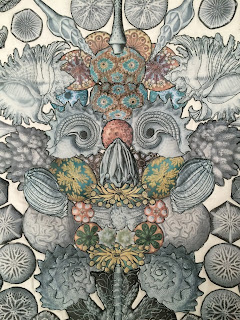Have a small bit of an obsession with skulls and Memento Mori (Latin translation: "remember (that you have) to die").
Memento Mori is the medieval Latin theory and practice of reflection on mortality, especially as a means of considering the vanity of earthly life and the transient nature of all earthly goods and pursuits. It is related to the ars moriendi ("The Art of Dying") and related literature. Memento Mori has been an important part of ascetic disciplines as a means of perfecting the character, by cultivating detachment and other virtues, and turning the attention towards the immortality of the soul and the afterlife.
I think previous generations had a healthier approach to death than we have! We hide from it and try to evade, when it's as necessary as breathing and something we all face. As a society we elevate the young and beautiful and marginalise the older and wiser. Our arrogance and greed is destroying the air we breath.
Memento Mori is the medieval Latin theory and practice of reflection on mortality, especially as a means of considering the vanity of earthly life and the transient nature of all earthly goods and pursuits. It is related to the ars moriendi ("The Art of Dying") and related literature. Memento Mori has been an important part of ascetic disciplines as a means of perfecting the character, by cultivating detachment and other virtues, and turning the attention towards the immortality of the soul and the afterlife.
I think previous generations had a healthier approach to death than we have! We hide from it and try to evade, when it's as necessary as breathing and something we all face. As a society we elevate the young and beautiful and marginalise the older and wiser. Our arrogance and greed is destroying the air we breath.
In art, memento mori are artistic or symbolic reminders of mortality.
Growing up in a strong Catholic country, I was surrounded by religious symbolism and paraphernalia which can have a very strong effect.
I'm also a country girl at heart and a highly sensitive introvert, I'm happiest when out in nature and away from crowds. The natural world nourishes the soul and I'm always mesmerised by the beauty and design of the natural world.
It makes me so sad to see what we are doing to the wonderful planet, I fear for what my children will have to face.
So my Taiwan piece is "Memento Flori" a reflection of the beauty of the natural world and the transient nature of all things.
I used a new photo transfer method that I'm playing with and used images of natural forms from Ernst Haeckel's "Art Forms in Nature" which I photoshopped.
Had great fu playing around and building up the design!
I also looked at the work of Giuseppe Arcimboldo, one of my favourites.
Finally got round to stitching!
Close up
Some colour added.
Final version ready to go!





















